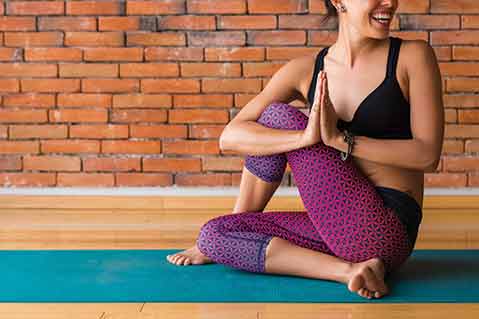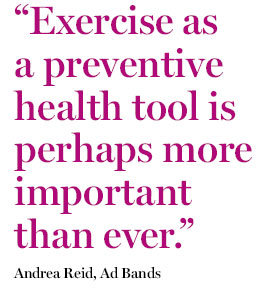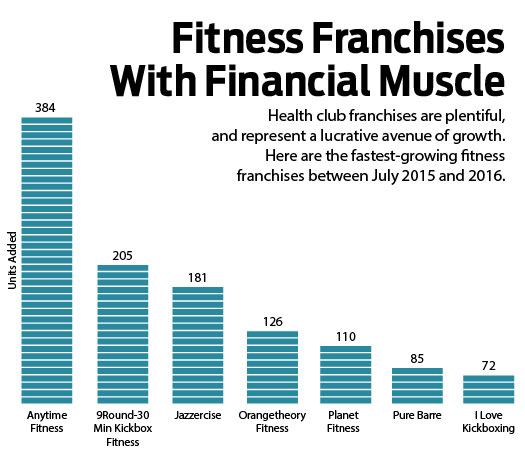Strategy May 10, 2017
Market to Target: Fitness
There’s little pain and lots of gain for distributors who bulk up on the growing exercise market.
Fitness has long been a popular target market for branded merchandise. In recent years, however, the sector has diversified significantly. From CrossFit to hot yoga to intense spin classes to Zumba at senior centers and much more, Americans are working up a sweat in more ways than ever before. And the sheer breadth of options is certainly a boon for distributors.

A 2015 study by Gallup/Healthways found that 56% of respondents said they exercised for at least 30 minutes three times or more the previous week, the highest monthly average since the poll was first launched in January 2008.
Paid memberships at health clubs and gyms are also on the rise. The International Health, Racquet & Sportsclub Association states that 55.3 million Americans were paid members at a health club in 2015, a steady rise from 54.1 million in 2014 and 52.9 million in 2013. The number of health clubs in the U.S. has also grown by 21% since 2011.
For sales reps that will sprint for fitness sales, a growing audience of buyers and end-users is great news. But the persistent health problems that plague most Americans due to lack of exercise and unhealthy eating also represent another opportunity. Obesity remains a chronic problem; according to the Centers for Disease Control, about 71% of Americans age 20 and above are overweight; 38% of those people are obese. In addition, CDC studies have found that nearly 80% of adult Americans do not get the recommended amounts of exercise each week (at least 2.5 hours of moderate-intensity aerobic exercise).
Obesity-related illnesses come with an estimated yearly price tag of between $147 billion and $210 billion in annual healthcare costs, according to The State of Obesity, a project from the Trust for America’s Health and the Robert Wood Johnson Foundation. Illness also contributes to increased job absenteeism, which costs approximately $4.3 billion in lost productivity every year.
“Costs are on the rise and the future of the U.S. health insurance industry is uncertain,” says Andrea Reid, promotional market sales manager of Ad Bands (asi/34345), “so using exercise as a preventive health tool is perhaps more important than ever.”
As healthcare providers continue to encourage exercise and balanced diets while a variety of fitness regimens are offered in communities across the country, distributors now have ample opportunity to target this market.
Exercising Choice
Americans want options, and the fitness market has delivered. All-purpose gyms offer space for self-directed workouts, while boutique studios that host small classes in yoga and Pilates have gained traction, along with new franchises like CrossFit, SoulCycle, Orangetheory, Pure Barre and Hoop Dance. In California in particular, CrossFit gyms and spin studios continue to celebrate grand openings, says Joshua Ebrahemi, vice president and partner at Top 40 distributor Jack Nadel International (asi/279600) in Los Angeles.
Members of these places are devoted and proud to display their allegiance. That makes logoed items crucial, says Kevin Scharnek, president of 14 West (asi/197092) and owner of three Orangetheory Fitness franchises. “Members want to identify themselves with our brand,” he says. Creating products in step with current retail trends is important because fitness fanatics won’t settle for less if it doesn’t measure up to their favorite brands, such as Under Armour and Lululemon.
Know the End-User
More than 80% of American yogis are women. Yoga studios and lifestyle brands will increasingly market yoga’s health benefits to attract both the ballooning population of aging baby boomers and young millennials with their interest in living mindfully.
Like their workout regimens, target audiences in the fitness market want choices when it comes to the branded gear they’ll put to use. Consider pitching packages of items for new clients, loyalty appreciation or promoting a new class or service. For example, pair a performance tank top with a towel, activity tracker or duffel bag to round out a new member kit. Yoga mats could be offered to the first 20 people who sign up for a new session.
Products can also pull double duty. Working with a distributor, a national gym chain opted for running belt fanny packs from Hit Promotional Products (asi/61125) as a giveaway for each new premium membership. (The gym had used towels and drawstring backpacks in the past.) The belts proved so popular that they also made them available for purchase for current members. There was an added bonus: by using the belts to hold their essentials, gym members left fewer bags lying around, which eliminated clutter.
Exercise items like jump ropes and weights can also serve as a branding vehicle. Ad Bands took advantage of an opportunity to tap into the fitness market about 15 years ago with its line of imprinted durable rubber pieces called Workout Bands, perfect for both high- and low-impact exercise at gyms and rehab centers. As demand for the Bands continued to swell, the company launched the Resistor Strip, a rubber band measuring 3.5’ x 3” with high-quality digital printing.
“It’s become one of our top sellers,” says Reid. “Sales volume more than doubled between 2015 and 2016.” Both Workout Bands and Resistor Strips are a great tools for functional fitness, which help the elderly improve balance and perform activities of daily living, such as pushing and lifting. In addition, the products’ portability makes them great items for travelers, allowing distributors to tap into fitness options like the hospitality market.
Alive and Wellness
The fitness ecosystem is so large that it ties into a number of related markets. Physical therapy and rehab centers effortlessly bridge the gap between health and fitness. Weight loss centers and nutritionists’ offices are perfect clients for journals for tracking personal progress and food intake, as well as portion-control food containers and fruit-infuser tumblers. Ebrahemi says new offerings in drinkware (specifically sports bottles made of lightweight BPA-free Tritan plastic) have been very popular with fitness clients in recent months, highlighting just how well many products work for both fitness and health clients.

Among the entities that group health and fitness under one umbrella, perhaps the most prominent and trendy are corporate wellness programs. Companies have proactively encouraged healthier habits among employees (thereby controlling healthcare costs and saving on lost productivity) while at the same time garnering brand impressions from logoed fitness products that workers will use at off-site workouts.
“Wellness programs have been growing with our clients every year for the last five years,” says Ebrahemi. “As insurance and healthcare costs rise, companies are focusing on alternative methods and programs to keep their staff healthy.” Many of these wellness programs include online incentive programs along with encouragement to attend on-site gyms or taking breaks for long walks.
Mark Ziskind, COO of Top 40 distributor CSE (asi/155807), says the most popular corporate wellness programs his company has worked on have engaged employees while providing ongoing giveaways of incentive items such as FitBits, yoga mats, apparel, towels, stretch bands and drinkware.
“At CSE, we run a Biggest Loser program every year,” he says. “Along with the weight loss component, it also includes mindfulness training, yoga, fitness boot camps and healthy eating classes. We give away items like T-shirts, water bottles to encourage increased consumption of water and healthy snack options.”
Crossover Appeal
Corporate wellness emphasizes the goal of healthy activity during the day. To support that, businesses are becoming increasingly supportive of versatile apparel that can be worn for both professional and performance functions – items polished enough to meet a client in and yet active enough to withstand a rigorous fitness session. This category of clothing is called “athleisure,” and it’s far from just a business phenomenon. Performance clothing has infected all facets of fashion and is worn now by just about anyone.
“We created a term called ‘Indescribables’ because athleisure actually became too limiting,” says Michael Snyder, vice president global markets for Polyconcept North America.
As a result, consumers have adopted the most popular retail fitness brands regardless of their workout habits. “People that have never set foot inside a gym wear Lululemon because it’s a lifestyle,” says Scharnek.
Brandito (asi/325944), based in Richmond, VA, has sold fitness-inspired apparel to wide a range of decidedly non-fitness clients, from financial advisers to real estate agents buying apparel as closing gifts. Vice President Kevin Mullaney says that besides T-shirts, the distributor’s top sellers are fleece vests and quarter-zip pullovers, which men often pair with a button-down underneath to keep the look professional.
Scharnek says his company recently provided apparel for a large customer at an executive leadership summit in Texas. And what did they want? Not a polo, but an active lifestyle fitness pullover which he says is the perfect garment for that “Sunday morning cup of coffee.”
How can you determine if your corporate clients are right for crossover apparel? Mullaney uses his powers of observation to learn what level of dress is accepted at a company, pointing out that the East Coast financial district dresses a lot differently than a California tech firm. “By the time you get to the meeting room with your client,” he says, “you’ve gotten almost 30 seconds of incredible data just walking around the office and seeing what their employees are wearing.”
Of course, the fitness community hasn’t abandoned fitness apparel and related items. In fact, it’s celebrated more than ever, thanks to the glorification of active lifestyles on social media, apps and blogs. Leery of being seen in a tattered T-shirt, members of the fitness community have upped the bar on how they look doing the activities they love. Leah Hulon, designer for performance apparel supplier Expert Brand (asi/53404), says there are many followers on social media sites like Instagram dedicated to the yoga or CrossFit lifestyle.
Susan Thomas Springer is a contributing writer for Advantages.

